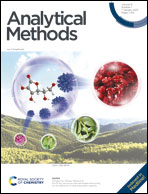A rhodamine based chemodosimeter for the detection of Group 13 metal ions†
Abstract
A new rhodamine derivative, HL-CIN, derived from a reaction between N-(rhodamine-6G)lactam-ethylenediamine (L1) and trans-cinnamaldehyde, is reported here for the colorimetric and fluorogenic sensing of Group 13 trivalent cations, namely Al3+, Ga3+, In3+ and Tl3+. The absorption intensity of the probe increases significantly at 530 nm whereas the fluorescence intensity enhances massively at 558 nm upon interaction with these metal ions. Other relevant metal ions could not impart any noticeable color change or fluorescence enhancement. The quantum yield or fluorescence life time of HL-CIN increases considerably in the presence of these Group 13 metal ions. Different spectral studies such as ESI-mass, FT-IR, 1H and 13C NMR spectra, establish that HL-CIN undergoes hydrolysis in the presence of the trivalent cations and a rhodamine species in its ring opened form (i.e. N-(2-aminoethyl)-2-((6Z)-3-(ethylamino)-6-(ethylimino)-2,7-dimethyl-6H-xanthen-9-yl)benzamide, (L2)) along with cinnamaldehyde are produced. The rhodamine species in its ring opened form (L2) is responsible for the color change and strong increment in the absorbance and fluorescence of HL-CIN with Group 13 cations. Interaction between L1 and these metal ions could not produce the same outcome. It has been used in test paper strips and to detect these cations in real samples.

- This article is part of the themed collection: Analytical Methods HOT Articles 2022


 Please wait while we load your content...
Please wait while we load your content...